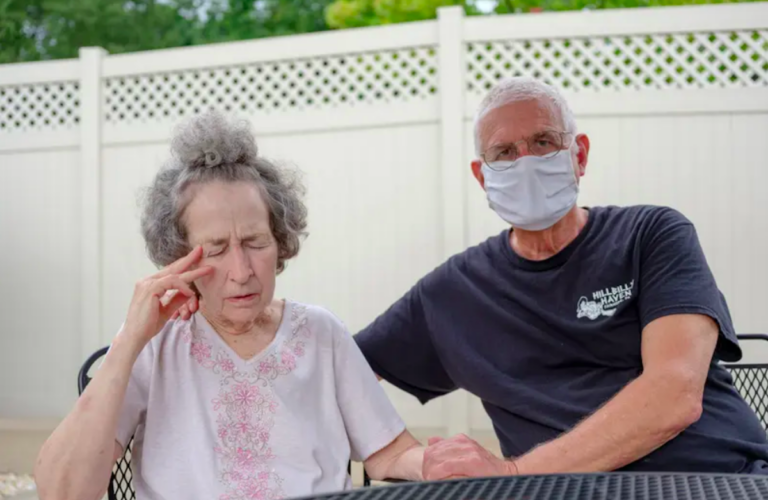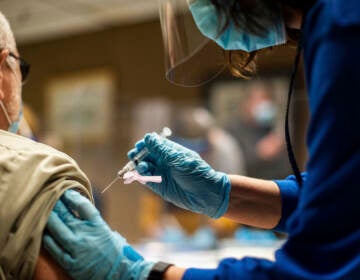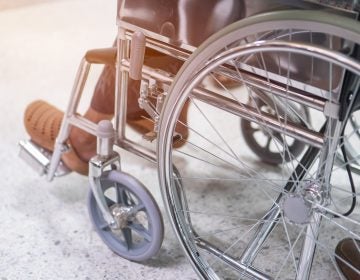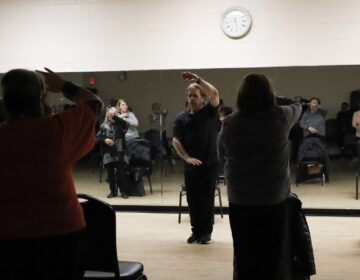Pa.’s looming dementia care crisis, by the numbers
Pennsylvania is headed for a profound eldercare crisis, experts warn.

Pat Loughney (right) cared for his wife, Candy, in their home until she went into anaphylactic shock after eating medicated soap. Candy is one of 280,000 Pennsylvanians over the age of 64 living with Alzheimer’s disease, the most common cause of dementia. (Quinn Glabicki for Spotlight PA / Publicsource)
This story originally appeared on Spotlight PA.
Pennsylvania is headed for a profound eldercare crisis, experts warn, as Alzheimer’s disease and dementia rates continue to climb, the state’s readiness plan continues to falter, and the exorbitant costs of care pressure state budgets and family budgets alike.
Spotlight PA and PublicSource looked at the remarkably high stakes in Pennsylvania, home to one of the nation’s oldest populations, and found a slew of statistics demonstrating both the urgency of the problem, the glacial pace of the response, and the dollar amounts behind a “public health crisis with a looming financial crisis on top.”
Here are the figures that stand out:
Delayed action
Seven: The number of years since a state-commissioned plan outlined action items to prepare for and respond to Pennsylvania’s growing dementia crisis
Eight: The number of action items (out of nine chosen) still unfinished or not yet started
Outnumbered
1,500: The number of board-certified geriatric psychiatrists nationwide
6 million: The number of Alzheimer’s patients nationwide
13 million: The projected number of Alzheimer’s patients nationwide by 2050
Care crunch
320,000: The projected number of Alzheimer’s cases in Pennsylvania by 2025
61,760: The number of those cases that are likely to be severe, based on NIH-funded research, and more likely to require full-time, dementia-specific services at an eldercare facility
17,157: The current capacity for full-time, dementia-specific services inside Pennsylvania’s state-licensed eldercare facilities
Need gaps
21,290: The increase in the number of Pennsylvania Medicaid and Medicare recipients with Alzheimer’s disease or a related dementia disorder seen between 2015 and 2020
$50: The amount Pennsylvania’s Medicaid reimbursement — a primary payer of dementia care services in nursing homes — falls short per resident, per day, according to the Pennsylvania Health Care Association, which represents for-profit facilities
Limited support
4,564: The number of people who received reimbursements from Pennsylvania’s Caregiver Support Program in 2020
500,000: The estimated number of unpaid family caregivers statewide
Sticker shock
$58,692: The average annual cost of memory care for an individual in Pennsylvania
$34,352: Average annual income per individual in Pennsylvania, according to the U.S. Census Bureau
Hidden costs
$3.7 billion: The amount spent annually through Pennsylvania’s Medicaid program for Alzheimer’s care, according to the Alzheimer’s Association
$10 billion: The value of unpaid care provided annually by Pennsylvanians to a loved one with Alzheimer’s disease or dementia, which advocates say demonstrates a far greater need for state-supported services

Get daily updates from WHYY News!
WHYY is your source for fact-based, in-depth journalism and information. As a nonprofit organization, we rely on financial support from readers like you. Please give today.






